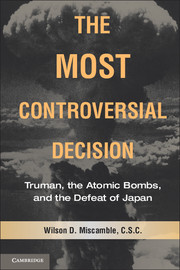Book contents
- Frontmatter
- Contents
- Acknowledgments
- Map 1 The Atomic Bombing of Japan
- Introduction: The Most Controversial Decision
- 1 Franklin Roosevelt, the Manhattan Project, and the Development of the Atomic Bomb
- 2 Harry Truman, Henry Stimson, and Atomic Briefings
- 3 James F. Byrnes, the Atomic Bomb, and the Pacific War
- 4 The Potsdam Conference, the Trinity Test, and Atomic Diplomacy
- 5 Hiroshima, the Japanese, and the Soviets
- 6 The Japanese Surrender
- 7 Necessary, But Was It Right?
- 8 Byrnes, the Soviets, and the American Atomic Monopoly
- 9 The Atomic Bomb and the Origins of the Cold War
- Suggested Readings
- Index
9 - The Atomic Bomb and the Origins of the Cold War
Published online by Cambridge University Press: 05 June 2012
- Frontmatter
- Contents
- Acknowledgments
- Map 1 The Atomic Bombing of Japan
- Introduction: The Most Controversial Decision
- 1 Franklin Roosevelt, the Manhattan Project, and the Development of the Atomic Bomb
- 2 Harry Truman, Henry Stimson, and Atomic Briefings
- 3 James F. Byrnes, the Atomic Bomb, and the Pacific War
- 4 The Potsdam Conference, the Trinity Test, and Atomic Diplomacy
- 5 Hiroshima, the Japanese, and the Soviets
- 6 The Japanese Surrender
- 7 Necessary, But Was It Right?
- 8 Byrnes, the Soviets, and the American Atomic Monopoly
- 9 The Atomic Bomb and the Origins of the Cold War
- Suggested Readings
- Index
Summary
The devastating atomic blows against Hiroshima and Nagasaki certainly helped end World War II, but did they simultaneously plant the seeds for future conflict among the victorious allies? Did the atomic blasts constitute in some way the opening shots in the Cold War struggle that dominated the postwar era? Could the Cold War have been avoided if Truman had refrained from using the atomic bomb against Japan? Some attention surely must be given these questions here, although the detailed story of how nuclear weapons contributed in the long contest between the United States and the Soviet Union lies beyond the scope of this study. Understanding the American approach regarding these weapons in the early Cold War casts a certain light back on Hiroshima and Nagasaki, and it puts their use into a broader perspective. It clarifies that the atomic bomb did not cause the Cold War but rather it helped shape how the Cold War developed. The issues of nuclear weapons control and competition became unavoidably intertwined with the developing Cold War confrontation between the Soviet Union and the United States. Yet, it must be emphasized, they reflected the conflict rather than serving to provoke it. Comprehending the essential and immediate cause of outbreak of the Cold War assures that one avoids any exaggeration of the place of nuclear weapons in precipitating the bitter struggle.
- Type
- Chapter
- Information
- The Most Controversial DecisionTruman, the Atomic Bombs, and the Defeat of Japan, pp. 138 - 152Publisher: Cambridge University PressPrint publication year: 2011



